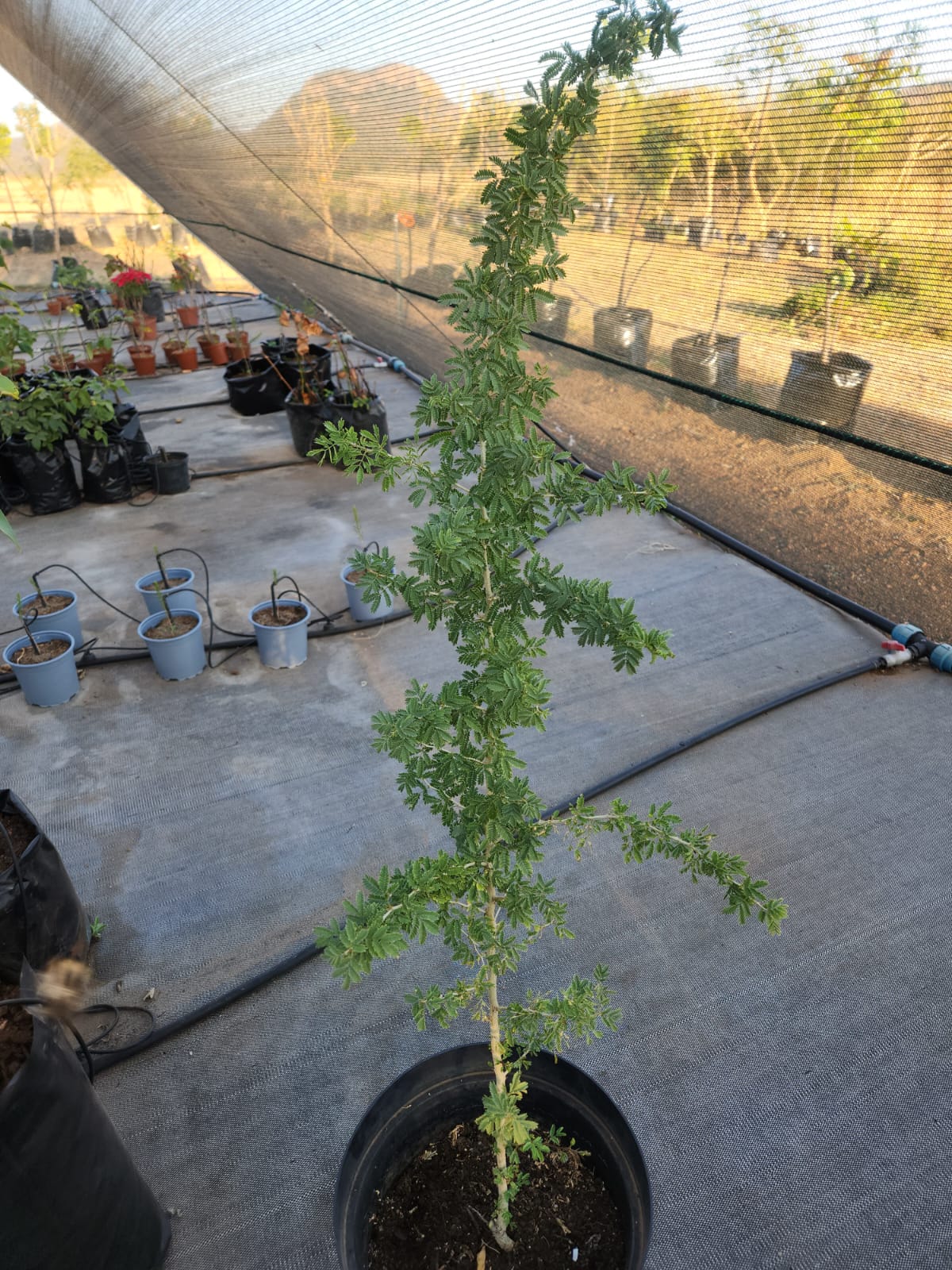Ana Tree (Anaboom) #
Faidherbia albida

Quick Info #
- Distribution: widespread on the African continent
- Family: Fabaceae
- Florescence: March to September
- Fruiting: September to December
- Leaf habit: deciduous
- Name origin: “albida” means “whitish” and refers to the colour of the trunks
- Other names: apple-ring acacia, mogabo (Northern Sotho), musangu/musenga (Shona), umhlalankwazi (Zulu), umpumbu (Ndebele), winter thorn
Description #
The ana tree is not only a very fast grower, but can stand rather tall – commonly around 20 metres, but capable of even 30 metres, making it one of the highest acacias. A protected tree in South Africa, it grows in waterlogged soils along floodplains, rivers and swamps.
The twisted, non-splitting pods of the ana tree are unusually large and contain shiny brown seeds. The pods themselves are orange and red-brown. The leaves are pinnate and the flowers are arranged in creamy-white spikes. Trunks may vary from greenish-grey to whitish-grey and the young branches have a characteristic zig-zag shape. The tree is drought-resistant, but its resistance to frost, when fully grown, is very limited – about five days a year.
The ana tree is unique in that it’s the only “acacia” with straight thorns and elongated inflorescences. It is also an oddball because it is leafless during the wet season and grows its leaves in the dry season.
A fun rumour that went to press back in the eighties is that a beautiful group of ana trees 15 km northwest of Potgietersrus is called “Livingstone’s trees” because David Livingstone camped under their canopies.
Uses & Ecology #
The strange shedding tendency mentioned earlier, known as inverse phenology, has a practical advantage. The nakedness of the branches in the rainy season means it won’t shade the crops that much. It also means that shade is provided during droughts, and that the nutrients in the soil are increased to help feed the new season’s crops. This latter point is part of what makes the tree an effective soil improver and stabilizer. The other factor is the extensive root system which, when several ana trees are planted in a row, helps prevent soil erosion.
The ana tree is also considered a valuable fodder tree for wild animals (elephants, giraffes, impalas, kudus, nyalas) and livestock. Animals eat both the leaves and the pods.
The seeds can be boiled and eaten, but first they must be removed from the pods. The pods themselves are, however, sometimes dried and ground into an edible flour. It is believed that the pods have been used as fish poison.
A bark extract is used for bleeding, diarrhoea and eye inflammation. The extract is also used as an emetic. In Namibia, another fascinating purpose for the bark is to use the bark strips as dental floss. You see, the bark is said to contain fluoride and understood to clean teeth. The bark and roots are furthermore used to treat respiratory infections, digestive disorders and malaria.
An acacia gum can be obtained from the stems. The wood can be burnt and used for potash in soap recipes. It is used to make boxes, canoes, drums, furniture, handicrafts, oil presses and utensils. It is also used as fuel and to make charcoal.
The ana tree is of exceptional ornamental quality, becoming a striking giant in parks and large gardens.
References #
- Coates Palgrave, K. & P. & M. (1989). Die Suid-Afrikaanse Boomgids. Johannesburg: Central News Agency.
- Difoloko, J.A. (2025) Faidherbia albida. Available at: https://pza.sanbi.org/faidherbia-albida (Accessed: 18 September 2025).
- Heuzé, V. & Tran, G. (2016) Apple-ring acacia (Faidherbia albida). Available at: https://www.feedipedia.org/node/357 (Accessed: 18 September 2025).
- Hyde, M.A., Wursten, B.T., Ballings, P. & Coates Palgrave, M. (2025) Flora of Zimbabwe: Species information: Faidherbia albida. Available at: https://www.zimbabweflora.co.zw/speciesdata/species.php?species_id=126270 (Accessed: 18 September 2025).
- Tropical Plants Database, Ken Fern. (2024) Faidherbia albida. Available at: https://tropical.theferns.info/viewtropical.php?id=Faidherbia+albida (Accessed: 18 September 2025).
- Van Wyk, B & P. (1997) Field Guide to Trees of Southern Africa. Cape Town: Struik Publishers.
- Venter, F & J.A. (2002) Benut on Inheemse Bome. Pretoria: Briza Publications.
- Zambezi Grande. (no date) What makes the Ana Tree so remarkable. Available at: https://www.zambezigrande.com/uncategorized/what-makes-the-ana-tree-so-remarkable/ (Accessed: 18 September 2025).
Caution: Consult a qualified health practitioner before considering medically using or ingesting any plant parts. Any mentioned traditional uses are based on cultural practices and anecdotal evidence. They are not necessarily clinically proven or supported by modern scientific studies.